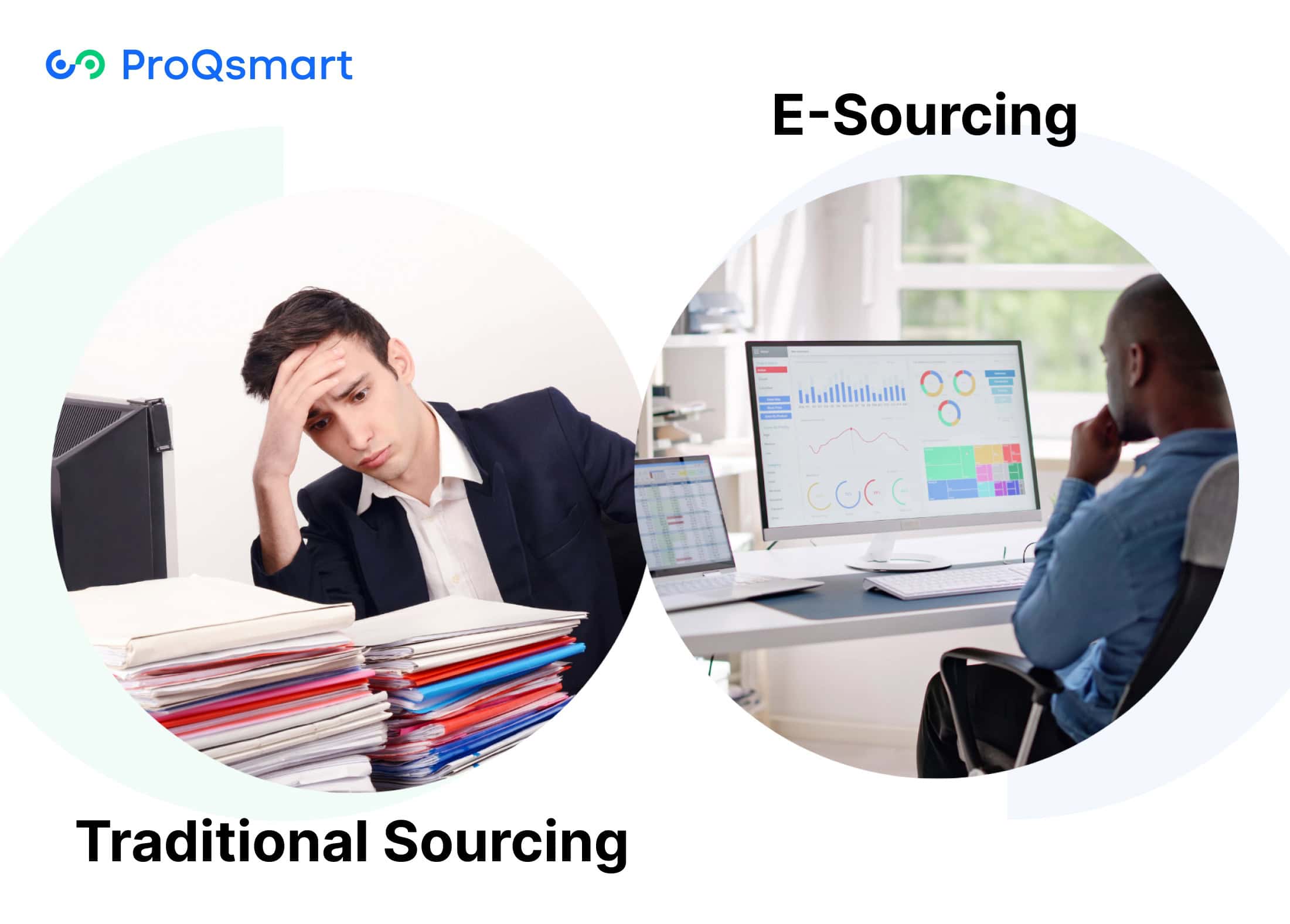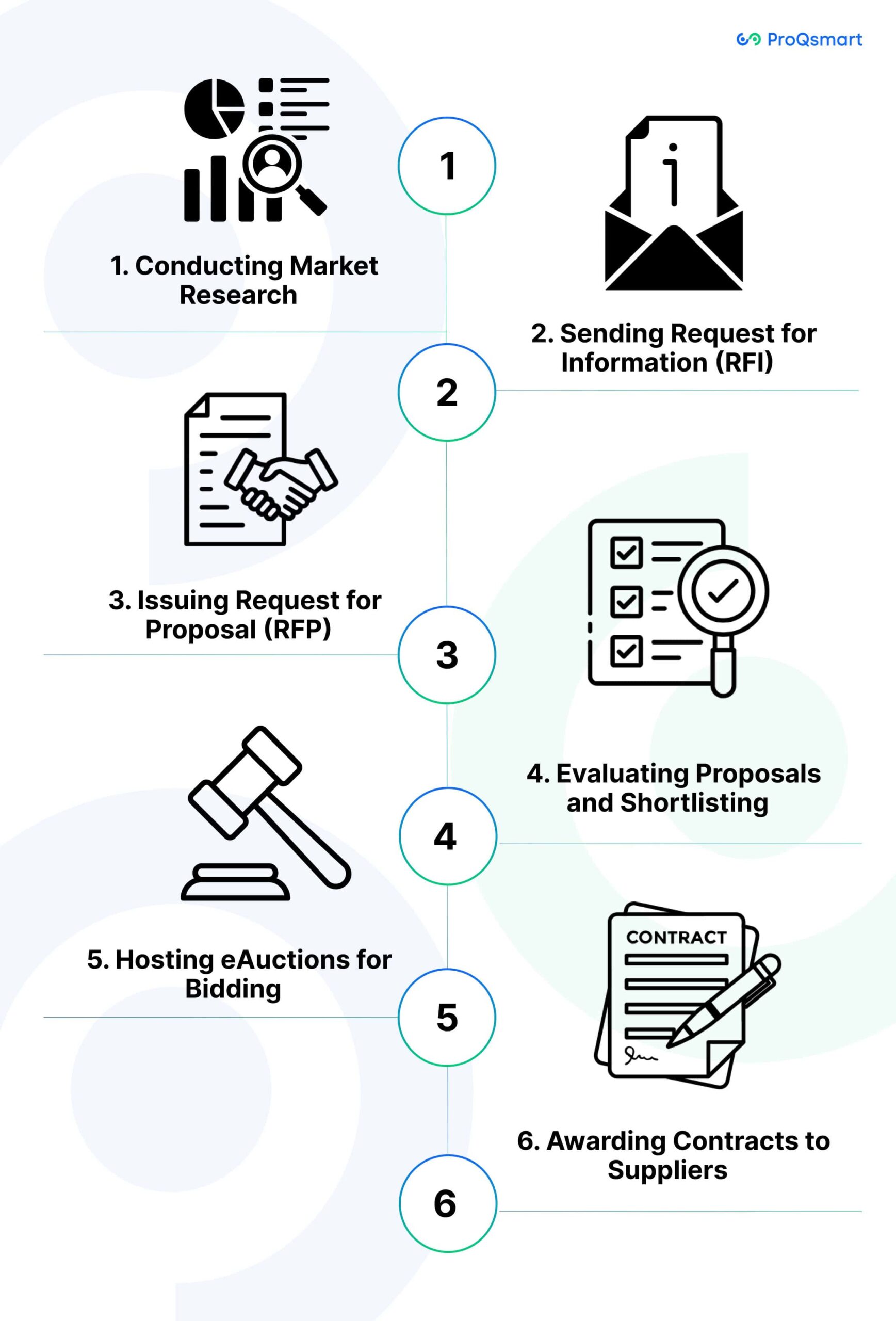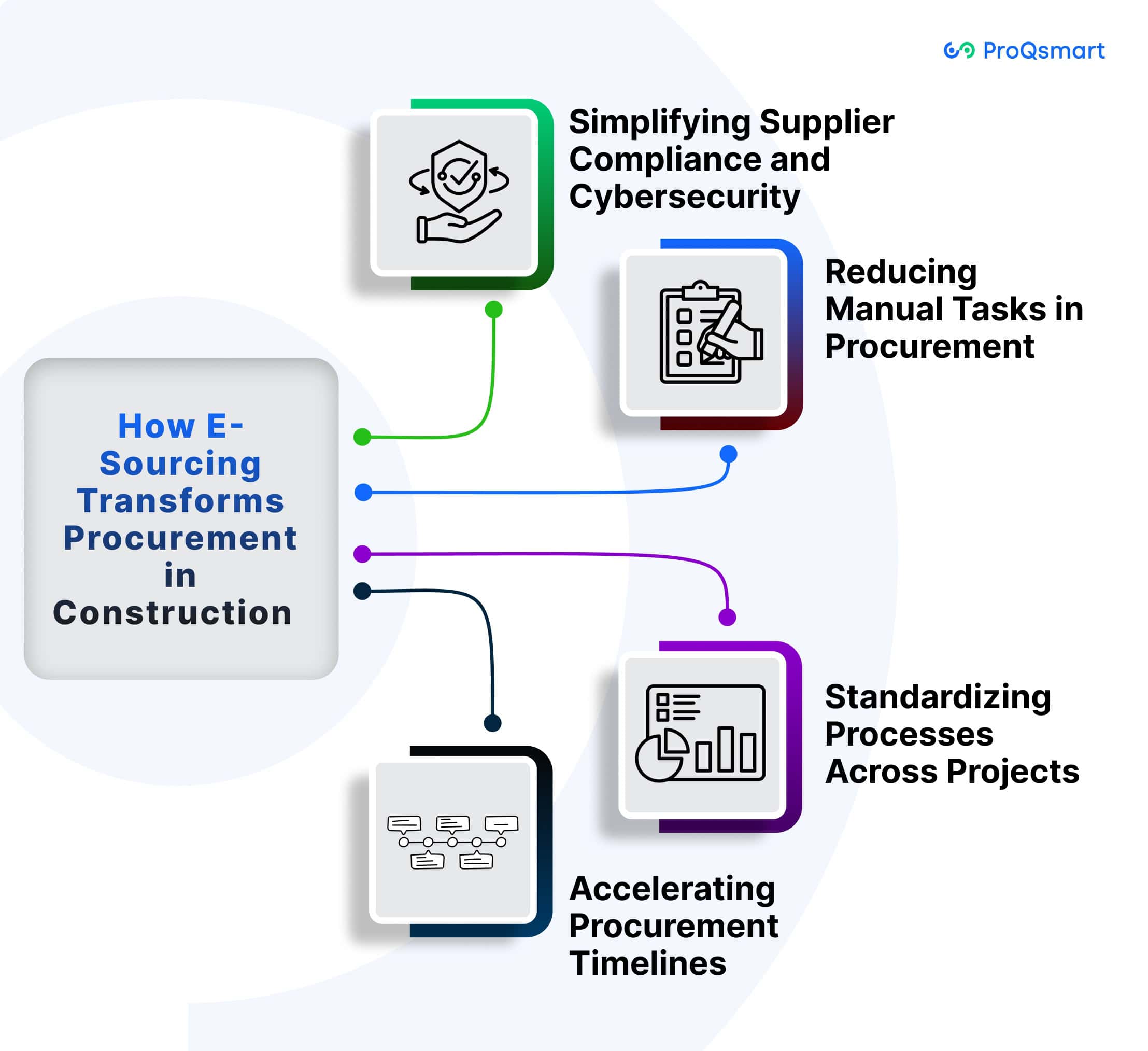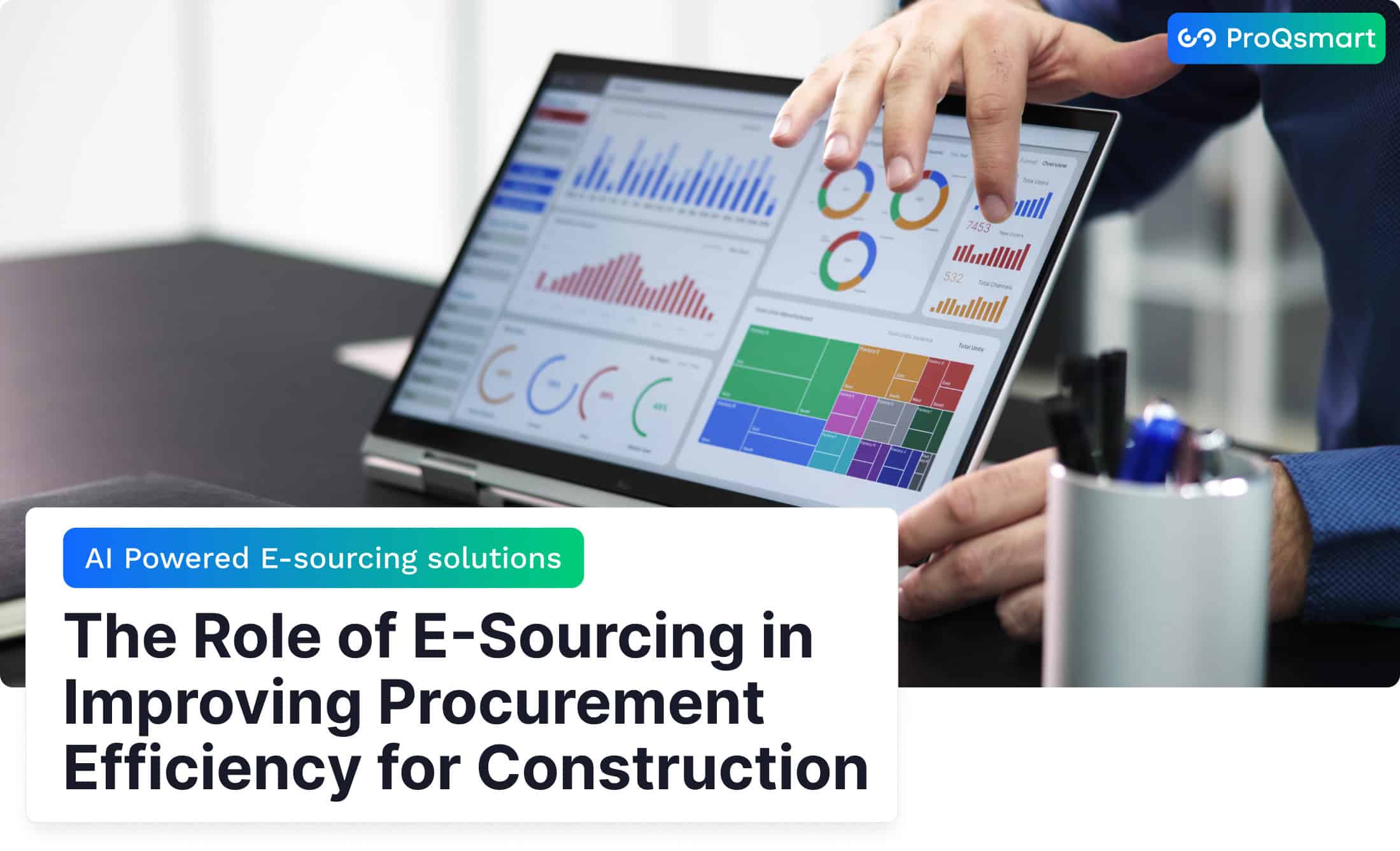E-Sourcing is the digital method of conducting procurement processes. It simplifies the entire process from supplier discovery to contract negotiation using online platforms and tools. It allows enterprises to simplify procurement operations, improve collaboration with suppliers, and realize cost savings through the automation of manual processes.
With e-Sourcing, organizations benefit from a broader supplier network, real-time data analysis, and better decision-making capabilities. In today’s competitive market, e-Sourcing fits well with the demands for speed, transparency, and adaptability that today’s procurement landscape requires.
Besides, by harnessing technology, it minimizes time spent manually gathering data, eliminating the risk and hassle of noncompliance while making sustainable sourcing more efficient. E-Sourcing tools also help simplify complicated processes to reduce the burden of soliciting competitive supplier bids and proposal evaluation.
They further maintain accuracy, integrity, and consistency across all procurement operations.
What is E-Sourcing?
E-Sourcing, or electronic sourcing, is changing the way procurement professionals conduct business. It incorporates advanced online tools and platforms to streamline and optimize every sourcing activity. This holistic approach is crucial for today’s supply chain operations.
At its core, E-Sourcing focuses on the use of digital solutions to manage various aspects of the sourcing lifecycle. These tools streamline procurement functions, reducing manual effort, repetitive tasks, and the time required to complete strategic objectives.
For instance, pre-purchase questionnaires (PQQs) and requests for information (RFIs) allow procurement professionals to evaluate potential suppliers systematically. With E-Sourcing, supplier engagement is more competitive and efficient, as tools such as eAuctions open the bidding process for competitive bidding to all qualified suppliers.
Key Differences Between Sourcing and E-Sourcing

Feature | Traditional Sourcing | E-Sourcing |
Process | Manual, paper-based | Digital, automated |
Speed/Time | Slower | Faster, accelerates processes |
Cost Benefits | Higher operational costs | More cost-effective |
Transparency & Visibility | Limited visibility | Complete, instant updates |
Supplier Relations | Personal relationships | Data-based, expandable |
Data Management | Struggles with documentation | Centralized document storage, data analytics |
Technology | Relies on phone calls and paperwork | Cloud-based systems, digital tools |
Market Knowledge | Limited | Helps build market knowledge |
Communication | Time-consuming, manual | Simplified |
Evaluation | Subjective | Objective, real-time evaluation of offers |
Strategic Approach | Fails to provide a strategic approach | Enhanced strategic purchasing |
Sustainability | N/A | Supports sustainability goals |
Risk Management | Relies on key personnel | Structured approach, reduces reliance on individuals, real-time data for risk mitigation |
Compliance | Manual process | Helps ensure regulatory compliance |
Benefits of E-Sourcing in Construction
E-Sourcing is transforming the overall procurement process in the construction industry by addressing specific challenges while delivering tangible E-Sourcing benefits. Besides, by utilizing superior E-Sourcing software, construction firms can strategically plan and execute sourcing events, effectively cutting out waste and improving supplier collaboration.
Cost Reduction and Profitability Improvement
Competitive bidding facilitated through E-Sourcing platforms allows construction firms to lower their procurement costs by up to 20%. By automating manual tasks and consolidating data on one platform, E-Sourcing removes complexity and streamlines processes. Consequently, it decreases requisition-to-order cycles by 66% and saves 58% in costs.
These financial decisions are further made easier by transparent pricing that comes with this more efficient process. It significantly helps open up your bandwidth for more strategic work. For instance, firms that utilize E-Sourcing can print out comprehensive Excel summaries to use during post-event analysis to make sure resources are allocated effectively.
Thus, these practices eventually lead to significant realization of profitability and also illustrate the way technology is streamlining procurement for construction projects.
Enhanced Project Quality and Timelines
Choosing the right suppliers is important to keep up with project quality. E-Sourcing tools make it easy to ensure all supplier responses are effectively reviewed and scored through manual processes and scoring matrices. This results in better supplier selection and creates more successful projects.
With a centralized platform like ProQsmart, E-Sourcing accelerates procurement processes, allowing for quicker turnarounds and on-time responses from suppliers. Correspondingly, construction firms benefit from reduced delays and more timely projects. These improvements evidently have become increasingly needed to maintain client satisfaction and increase productivity.
Risk Mitigation and Compliance Assurance
Adhering to procurement regulations is essential in construction. E-Sourcing simplifies compliance by providing transparent and auditable processes, ensuring alignment with industry standards. Risk identification and management explicitly become more effective with centralized data access.
For instance, firms can also maintain audit trails and evaluate supplier risks proactively, mitigating potential disruptions. These strategies safeguard construction projects and protect investments.
Competitive Advantage for Construction Firms
In this way, E-Sourcing gives construction firms the flexibility to respond to changing market conditions and stay one step ahead of the competition. Streamlined, automated processes and more collaborative tools save time in supplier negotiation and relationship management, which builds trust and nurtures innovation.
Using E-Sourcing for smart, strategic growth not only opens the door to differentiating your firm in a competitive market, but it helps you deliver operational excellence.
Increased Transparency and Collaboration
Transparency, as you might imagine, is incredibly important to efficient procurement. E-Sourcing platforms additionally provide a centralized location for documentation, allowing for increased accountability and collaboration between stakeholders.
Features such as real-time updates and data tracking ensure streamlined communication, leading to collaborative success. Further, firms are able to keep better track of RFQs. This proactive approach is definitely a solution to the 29% of construction professionals who report being unsatisfied with their existing processes.
Key Features of E-Sourcing Tools
The purpose of E-Sourcing tools is to enhance efficiency, transparency, and collaboration across procurement processes. Equipped with superior E-Sourcing software, platforms like ProQsmart streamline sourcing activities while encouraging strategic sourcing activities and effective E-Sourcing, ultimately improving procurement outcomes.
Feature | Benefit | Examples |
Analytics | Insights for informed decisions, trend analysis, and cost optimization. | Supplier performance metrics and spend analysis reports. |
Automation | Reduces manual tasks, minimizes errors, and accelerates processes. | Automated RFx generation and bid evaluation. |
Communication | Enhances supplier interaction, ensuring clarity and engagement. | Centralized messaging and integrated notifications. |
Supplier Discovery and Qualification
E-Sourcing software solutions improve supplier discovery with searchable databases and directories that provide easy access to a wide range of vendors. RFx invitations simplify the supplier qualification process, enabling procurement teams to screen and compare potential partners with ease.
When one construction firm tapped into a more robust supplier directory, it was able to filter vendors in accordance with national sanctions lists. They then awarded contracts using these scoring metrics.
Request for Information and Proposal
RFIs and RFPs are critical in getting insights and proposals from suppliers. E-Sourcing tools help to easily distribute and collect these documents, making sure everyone is on the same page regarding the project objectives.
When you have well-defined requirements, like a questionnaire to fill out, you get more focused proposals in return. For instance, dynamic RFP templates increased a manufacturing company’s response rates by 40% through automation.
Request for Quotation and Bidding
Moving through E-Sourcing, RFQs and eAuctions are handled effectively. One of the key advantages of electronic bidding is the increased accuracy and transparency.
One significant example is a major retailer realizing an average of 25% savings on commodities purchased through competitive eAuction formats.
Contract Award and Management
E-Sourcing tools allow contracts to be awarded through the platform, including features such as eSignatures and milestone tracking. Compliance monitoring and performance management are made easy with centralized repositories.
Regularly scheduled performance reviews and automated renewal alerts are among best practices.
Automation for Streamlined Procurement
Automation takes care of more than 90% of a sourcing professional’s work, such as RFx creation, bid evaluations and more. This cut down on errors, quickened cycles and increased transparency.
Processes such as purchase order administration and supplier performance rating are perfect candidates for realizing automation’s advantages.
Steps in the E-Sourcing Process

The E-Sourcing process is a systematic, data-driven approach to procurement that uses technology to make sourcing faster and more efficient. By automating key procurement functions and fostering data-driven decisions, E-Sourcing enables organizations to align procurement strategies with broader corporate objectives.
Here below are the 7 essential steps that go into it, all of which are necessary to ensuring successful procurement results.
1. Conducting Market Research
Market research is the bedrock of the E-Sourcing process. It requires a deep dive into the current state of the market, potential suppliers, and what’s driving the industry as a whole. This crucial step also helps you make the most informed sourcing decisions possible while helping to mitigate risk.
Supplier benchmarking, competitor analysis, and trend forecasting techniques are all useful in this phase. As an example, performing a deep dive into a supplier’s financial stability and production capabilities can identify the supplier’s reliability in the long run.
Besides, by leveraging data analytics tools, procurement teams are gaining greater visibility not just into supplier performance, but also market trends to identify opportunities to save costs.
2. Sending Request for Information (RFI)
An RFI is an early-stage tool to use for collecting information from potential suppliers. Developing a well-defined RFI document with focused questions regarding potential capabilities, certifications and or relevant experience will lead to productive responses.
Correspondingly consistent communication with suppliers fosters transparency, while structured templates help standardize responses for easier comparison. For example, categorizing RFI responses by supplier location, technology adoption, or capacity aids in narrowing down options for subsequent steps.
3. Issuing Request for Proposal (RFP)
The Request for Proposal (RFP) process adds a layer of structure to supplier engagement by clearly defining project needs, deadlines, and evaluation metrics. Structuring an RFP with clearly noted sections including scope, deliverables, and pricing provides explicit direction.
Creating clear and as well as objective scoring criteria, whether it’s technical knowledge or cost-effectiveness, makes it easier to compare and evaluate proposals. Effective RFPs strike a balance between being detailed and being brief.
4. Evaluating Proposals and Shortlisting
Proposal evaluation is based on systematic and public criteria to promote equity and transparency. Scoring systems, including weighted matrices, allow you to prioritize all the factors that matter, including cost, quality, and compliance.
Developing a shortlist is the process of identifying the most suitable suppliers to meet organizational objectives. Additionally, a useful tactic is to conduct side-by-side simulations or ask for third party case studies to help confirm supplier assertions.
Ongoing communication between all teams during this phase significantly helps to keep focused on the corporate goals.
5. Hosting E-Auctions for Bidding
E-Auctions bring suppliers in a competitive environment where they can bid against each other in real time, pushing cost savings down. Reverse auctions, in which suppliers undercut each other to win the contract, and forward auctions, for one-of-a-kind procurement needs, are the most popular varieties.
Additionally, automating auction rules with set bid increments or time extensions reduces time and error. For instance, running a reverse auction on complex logistics services can produce millions of dollars in additional savings, all while increasing supplier competition.
Hence, configurable auction templates make the initial setup process even easier.
6. Awarding Contracts to Suppliers
The contract award phase formalizes the winning bidders’ agreements after the bidding phase. Providing transparency around the terms and expectations sets everyone up for success.
Fortunately, E-Sourcing tools make this process easier with automated contract templates that include compliance tracking. For example, with proper software like ProQsmart you can set alerts for upcoming milestone deadlines so that you deliver on time.
Post-award, supplier performance monitoring is key to continuing procurement efficiency and realizing savings goals.
How E-Sourcing Transforms Procurement in Construction

E-Sourcing has transformed the procurement practices within the construction industry by bringing efficiency, transparency, and precision to previously convoluted processes. Almost 29% of professionals are dissatisfied with their Request for Quotation (RFQ) procedures. All this dissatisfaction underscores a palpable desire for digital solutions.
ProQsmart uses intuitive technology to bring together and simplify procurement processes. Therefore, this gives construction companies the power to control supplier relationships and project needs in a more effective manner.
Simplifying Supplier Compliance and Cybersecurity
As any construction procurement officer can tell you, compliance is key in the construction industry, where lives depend on following safety regulations and legal requirements. E-Sourcing tools make it easier to ensure compliance by automating the verification of certifications, licenses, and other required credentials.
Additionally, platforms like ProQsmart simplify procurement teams’ ability to store and track supplier documentation in a central location, further alleviating the administrative burden.
Cybersecurity is critical to protect sensitive information like pricing information and contract terms. The latest E-Sourcing platforms provide encrypted communication channels and secure storage, so procurement data stays under lock and key.
Construction firms can also improve compliance through E-Sourcing. This tool allows them to establish consistent supplier expectations and further track compliance through automated alerts and reporting tools.
Reducing Manual Tasks in Procurement
All of the manual tasks, like issuing RFQs manually or tracking responses, lead to a longer procurement process. E-Sourcing removes these inefficiencies by automating the distribution of RFQs, evaluation of proposals, and comparison of vendors.
For example, eAuctions help drive competitive bidding to create highly competitive environments where suppliers fight for business, delivering the lowest cost. Besides, by adopting automation, solutions such as ProQsmart also increase accuracy, minimizing human error during processes such as bid evaluations or the finalization of contracts.
Standardizing Processes Across Projects
Achieving consistency is critical for overseeing numerous construction projects at a time. E-Sourcing solutions bring standardization to the procurement workflow, providing templates for RFQs, RFPs, and eAuctions to streamline the process.
Moreover, this standardization allows procurement teams to quickly replicate proven strategies across projects. By leveraging ProQsmart, teams can set organizational-wide consistent procedures that lead to less variability and better facilitate collaboration with all project stakeholders.
Accelerating Procurement Timelines
For time-sensitive construction projects, E-Sourcing makes a tremendous difference. By automating key processes, such as bid submission and bid evaluation, automation makes it possible to shorten procurement timelines.
For instance, with E-Sourcing suppliers can submit bids and RFP responses through centralized portals, eliminating lost mail and delayed responses. Streamlined operations reduce cycle times so crucial materials can get to job sites more quickly.
Choosing the Right E-Sourcing Platform
Ultimately, choosing the right E-Sourcing platform is a strategic decision that will have immediate effects on procurement efficiency, supplier management, and cost optimization. The right E-Sourcing platform can provide a centralized workflow, improved collaboration among teams, and connect procurement initiatives to broader organizational goals.
To ensure you make the best possible decision, there are a few important factors that should be thoroughly evaluated.
Evaluation Criteria for E-Sourcing Software
When you’re evaluating E-Sourcing software, functionality should be your first priority. Automated tracking of open POs and invoice matching by line items provide tangible benefits. Further, improved visibility into inbound shipments through ASNs enables teams to make more informed decisions.
Integration with your current ERP systems is just as important, as seamless data flow between systems stops errors and inefficiencies in their tracks. For example, disparate legacy systems can fail ERP functionality, resulting in costly and time-consuming data inaccuracies.
Importance of User-Friendly Interfaces
A modern, intuitive user interface means faster buy-in and adoption with less time wasted and a reduced learning curve. Engaging UIs and intuitive designs encourage usage, which is clearly demonstrated by ProQsmart’s streamlined workflows and real-time collaboration tools.
Comprehensive training, as well as strong support systems are additional factors that drive usability, making sure that procurement teams can further get the most out of the software’s capabilities.
Role of Customer Support in Adoption
Strong customer support fuels successful implementation by ensuring users can quickly find solutions to challenges they encounter. ProQsmart takes this to heart with continual staff training, regulatory compliance assurance, and data transparency.
Therefore, this approach allows nature-based businesses to focus on operational excellence.
Assessing Scalability and Integration Features
Scalability makes sure the platform can expand as your organization does. Integration capabilities, like APIs, allow for smooth data sharing.
When real-time tracking of expenditures automatically aligns procurement with budgets, as ProQsmart’s solution does, that’s a great example of how integration improves functionality.
Aligning E-Sourcing with Business Goals
The ideal E-Sourcing solution supports goals such as reducing costs and improving efficiency. ProQsmart’s capital expenditure sourcing and superior E-Sourcing software for supplier performance monitoring exemplify how effective E-Sourcing can help organizations achieve larger strategic objectives.
Conclusion
E-Sourcing transforms how construction teams approach procurement. It streamlines supplier comparison, accelerates the bidding process, and reduces expenditure. These tools help public leaders make decisions more quickly and accurately. With tools such as real-time tracking and automated estimates comparisons, project teams can improve planning and lower the risk of delays.
Choosing the best E-Sourcing platform can be a game-changer. The right tools go beyond your immediate needs to enhance workflows and scale with your organization. They ensure that you remain on the cutting edge of market trends and can deliver on your projects’ goals without any holdups.
E-Sourcing isn’t an option anymore. It’s an imperative to a more intelligent and efficient procurement process in construction. Learn what’s out there, find the right tools to match your needs, and take the reins of your projects with confidence. Choosing the right platform will empower your success and help you stand out from the competition in the booming industry.
E-sourcing isn’t an option anymore; it’s an imperative for intelligent and efficient construction procurement. Discover how ProQsmart can transform your construction procurement process. Request a demo today!





